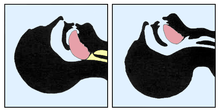| Admissions | Accreditation | Booksellers | Catalog | Colleges | Contact Us | Continents/States/Districts | Contracts | Distance Education | Emergency | Examinations | Forms | Grants | Hostels | Honorary Doctorate degree | Investment | Instructors | Lecture | Librarians | Membership | Professional Examinations | Programs | Progress Report | Recommendations | Research Grants | Researchers | Students login | School | Search | Seminar | Study Center/Centre | Sponsorship | Tutoring | Thesis | Universities | Work counseling |
Head-tilt chin-lift
Jaw-thrust maneuver
 The head-tilt chin-lift is the most reliable method of opening the airway. Head-tilt chin-lift — The head-tilt chin-lift is the primary maneuver used in any patient in whom cervical spine injury is not a concern. The simplest way of ensuring an open airway in an unconscious patient is to use a head tilt chin lift technique, thereby lifting the tongue from the back of the throat. Jaw-thrust maneuver Jaw-thrust maneuver — The jaw-thrust maneuver is an effective airway technique, particularly in the patient in whom cervical spine injury is a concern. The jaw thrust is a technique used on patients with a suspected spinal injury and is used on a supine patient. The practitioner uses their thumbs to physically push the posterior (back) aspects of the mandible upwards - only possible on a patient with a GCS < 8 (although patients with a GCS higher than this should also be maintaining their own patent airway). When the mandible is displaced forward, it pulls the tongue forward and prevents it from occluding (blocking) the entrance to the trachea, helping to ensure a patent (secure) airway. Opening the airway: head-tilt/chin-lift method. (1) Kneel at the side of the casualty's head or shoulders. (2) Place your hand (the hand closest to the casualty's head) on his forehead. (3) Apply firm, backward pressure with the palm of your hand. This pressure will cause the casualty's head to tilt back. (4) Place the fingertips of your other hand under the bony part of his chin, not on the soft flesh under his chin. Pressing on the soft flesh under the chin could result in blocking his airway. (5) Lift his chin with your fingertips. Continue to lift the lower jaw until his upper and lower teeth are almost brought together. The mouth should not be closed as this could prevent air from entering the casualty's airway. Jaw-thrust Method. The jaw-thrust (figure 3-3) is the preferred method of establishing an airway if you suspect that the casualty has a fractured neck. The jaw- thrust method moves the casualty's tongue forward (away from the airway) without extending his neck. |
